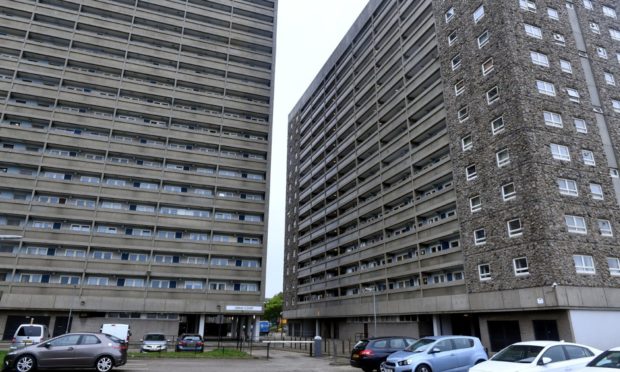Heritage bosses have awarded eight Aberdeen high rises the same protected status as iconic buildings like Marischal College and the Music Hall.
Historic Environment Scotland (HES) has given category A listing to post-war blocks across the city centre, due to their “outstanding architectural and historic interest”.
Gilcomstoun Land, Porthill Court, Seamount Court, Virginia Court, Marischal Court, Thistle Court, Hutcheon Court and Greig Court have been afforded the extra protections.
City council co-leader Douglas Lumsden said it was “disappointing” that local protest during the consultation, including from the local authority which owns a number of properties within the towers, was ignored.
Category A listing indicates the buildings, examples of ‘brutalist’ architecture, are of “outstanding importance” to the country.
The heritage quango described the multi-storeys as “some of the finest examples of social housing Scotland” and said they would be used to help tell the story of how the country emerged from the Second World War.
Residents and Aberdeen City Council, worried it would add additional cost and limit their ability to improve the properties.
Mr Lumsden, Conservative group leader, told The P&J: “It is really disappointing and not good news.
“As a council we will now have to look at what this means for the housing accounts, financially.
“I would imagine repairs may cost more in the future and it may have an effect on people who own homes within the blocks privately.
“Any repairs will take more time and, I imagine, be more costly.
“It just seems home owners and the local authority have been ignored by HES and it’s disappointing.”
He and co-leader Jenny Laing had urged HES to consider listing only one of the eight buildings, in order to reduce the burden on homeowners.
At the time of the public consultation, Mrs Laing raised concerns A-listing may make it more difficult to implement safety improvements ordered after the tragic Grenfell Tower fire.
But historians argued all eight, originally planned, towers still remaining standing added to the value and interest and was “reflected in the listing”.
Head of designations at HES, Elizabeth McCrone, said: “Listing doesn’t mean that a structure has to stay the same forever or remain in its original use. Rather, it means that there is a special interest that should be taken into account in the planning process.
“Exceptional architecture has always been built in Scotland and the Aberdeen flats should be celebrated as a key part of our 20th Century heritage, which help us understand the ambitions and aspirations of the city at that time.
“The Aberdeen flats tell us much about how the city and its architects responded to the challenges of housing large amounts of people in the city centre during the 1960s – a time of relative prosperity, low unemployment and optimism for the future.
“By designating and building these flats the Aberdeen City Architects Department were at the cutting edge of new thinking about town planning and housing. These buildings were very carefully designed and used superior materials to many of the less-successful types of multi-storey housing of this era which have now been demolished.”
Miles Glendinning, a professor of modern architecture who was contacted by residents, suggested the listing.
He previously backed the same protected status being awarded to the ‘Banana Flats’ in Edinburgh, which featured in the Irvine Welsh book, Trainspotting.
He said: “I’m a great admirer of the Granite City, and these buildings fit into its fabric, both in material – using granite in their construction – and in how they’ve been built into the historic and modern urban pattern.
“In architectural terms, these buildings stand out because architecturally and socially, they are a continuation of the civic-mindedness and pride of previous generations of great Aberdonians.
“They are also a social success, which for me is just as important as the architectural interest.”
HES urged to reconsider ‘appalling and ludicrous decision’
Aberdeen Central MSP Kevin Stewart was outright in his condemnation of the listing of the high rises.
In a letter to chief executive, Alex Paterson, the SNP government minister branded it a “ludicrous and appalling decision’ – and one that should be reconsidered.
He wrote: “This decision will likely impede future energy efficiency measures and district heating installation in the
flats meaning the people who live there will face higher energy bills or suffer all the detriments of a poorly heated home.
“Similarly, any sort of remedial or refurbishment works will now be made much more difficult and more expensive as a result of this decision.
“Was any consideration given to the people who actually live in these homes or did Historic Environment Scotland only consider the rather questionable benefit to special architectural and
historical interest?
“Beyond that, why was it necessary to list all eight buildings? Why not just list one? Albeit this would cause severe difficulties and hardship to the tenants of that single building, but at least the burden would be lessoned on the thousands of people now impacted.
“This is the exactly the type of issue that the tenants of these eight multi-storey buildings now face because of your decision to award A listed status.”
